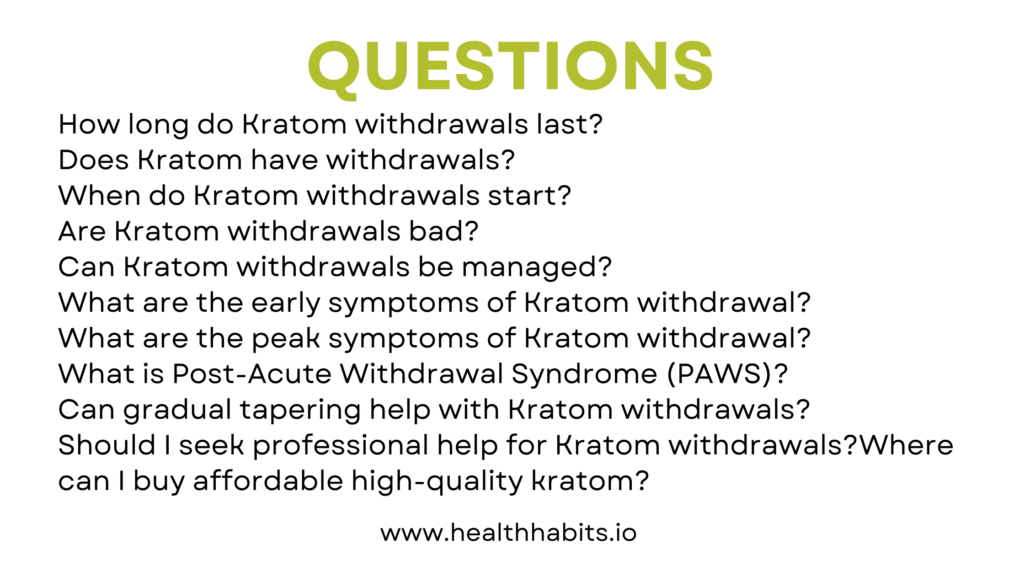Kratom, a tropical tree native to Southeast Asia, has become increasingly popular in recent years for its unique effects and potential benefits.
While many users turn to Kratom for its pain-relieving, mood-enhancing, and energy-boosting properties, it’s important to be aware of the potential for withdrawal symptoms if usage is stopped abruptly.
This article will explore Kratom withdrawals in detail, addressing common questions such as how long Kratom withdrawals last, when they start, and the severity of these symptoms.
Does Kratom Have Withdrawals?
Yes, Kratom can cause withdrawal symptoms.
Like many substances that affect the brain’s receptors, regular and prolonged use of Kratom can lead to physical dependence.
When using Kratom regularly, you may experience withdrawal symptoms if you immediately stop using.
Your body with go through kratom withdrawals while it is flushing your system and trying to get back on balance without this substance.
Why Do Kratom Withdrawals Occur?
Withdrawals occur because the body becomes accustomed to the presence of Kratom’s active compounds, primarily mitragynine and 7-hydroxymitragynine.
These compounds interact with opioid receptors in the brain, providing pain relief and other effects.
Over time, your body can develop a dependence on these compounds, and when they are no longer present, withdrawal symptoms can occur as your body attempts to return to its natural state.
When Do Kratom Withdrawals Start?
The onset of Kratom withdrawal symptoms can vary depending on several factors, including the duration and frequency of use, the dosage, and the individual’s unique physiology.
For high-tolerance kratom abusers, withdrawal symptoms can begin within 12 to 24 hours after the last dose of Kratom.
Early Symptoms of Kratom Withdrawals
In the initial stages, you may experience symptoms like:
- Irritability
- Anxiety
- Agitation
- Muscle aches
- Insomnia
These early symptoms can be uncomfortable but are usually not severe.
If you are experiencing these symptoms, it is encouraged to call your primary care doctor for in-depth support.
Peak Withdrawal Symptoms
Withdrawal symptoms typically peak within 2 to 3 days after the last dose.
During this peak period, symptoms can be more intense and may include:
- Nausea
- Vomiting
- Diarrhea
- Sweating
- Abdominal cramps
- Tremors
The intensity and duration of withdrawal symptoms will vary widely depending on your unique body, usage, and dependency.
How Long Do Kratom Withdrawals Last?
The duration of Kratom withdrawals can vary based on the factors mentioned earlier.
On average, most users find that the acute withdrawal phase lasts about 7 to 10 days.
However, some symptoms, particularly psychological ones like anxiety and depression, can persist for several weeks or even months in some cases.
Again, if you are noticing any of these symptoms, consult your doctor.
Acute Phase
The acute phase of withdrawal, which includes the most intense symptoms, usually lasts about 7 to 10 days.
During this time, individuals may experience a range of physical and psychological symptoms.
Post-Acute Withdrawal Syndrome (PAWS)
Users may experience a prolonged phase of withdrawal known as Post-Acute Withdrawal Syndrome (PAWS).
PAWS can include lingering symptoms such as anxiety, depression, and mood swings.
These symptoms can persist for weeks or months but generally decrease in intensity over time.
Are Kratom Withdrawals Bad?
The severity of Kratom withdrawals can vary significantly from person to person.
Some individuals may experience mild and manageable symptoms, while others may find the symptoms more severe and challenging to cope with.
Factors Influencing Severity
Several factors can influence the severity of Kratom withdrawals:
- Dosage and Frequency: Higher doses and more frequent use are associated with more severe withdrawal symptoms.
- Duration of Use: Long-term users are more likely to experience intense withdrawals.
- Individual Physiology: Genetics, overall health, and individual sensitivity to Kratom can all play a role in the severity of withdrawal symptoms.
How To Avoid Kratom Withdrawals
Kratom withdrawals can be a challenging experience, but there are several strategies you can implement to minimize or avoid these symptoms altogether.
The key to avoiding Kratom withdrawals is to use the substance responsibly and be mindful of your body’s reactions.
Here are some effective approaches to consider:
Gradual Tapering
One of the most effective ways to avoid Kratom withdrawals is through gradual tapering.
Instead of abruptly stopping Kratom use, gradually reduce your dosage over a period of time.
This allows your body to adjust to lower levels of Kratom slowly, minimizing the shock to your system.
By decreasing your dose incrementally, you can help your body adapt without experiencing severe withdrawal symptoms.
We recommend planning a tapering schedule, reducing your intake by small amounts every few days or weeks, depending on your initial dosage and how your body responds.
Responsible Usage
Using Kratom responsibly is another critical factor in avoiding withdrawals.
Do not exceed your recommended dosage and avoid daily use.
Regularly taking breaks from Kratom can prevent your body from developing a strong dependence on it.
By giving your body time to reset, you reduce the risk of building tolerance and the subsequent need for higher doses to achieve the same effects.
Additionally, sticking to lower doses can help you enjoy the benefits of Kratom without leading to physical dependence.
Stay Hydrated and Maintain a Balanced Diet
Proper hydration and nutrition play a significant role in how your body copes with changes, including withdrawal symptoms.
Staying well-hydrated helps flush out toxins and supports overall bodily functions, making the withdrawal process less taxing.
Similarly, a balanced diet rich in vitamins and minerals can bolster your immune system and improve your overall health, making it easier for your body to handle reduced Kratom intake.
Foods high in antioxidants, healthy fats, and proteins can provide the necessary nutrients to support your body’s recovery.
Seek Support
Having a strong support system can make a significant difference when trying to avoid or manage Kratom withdrawals.
Whether it’s friends, family, or a support group, surrounding yourself with people who understand and support your journey can provide emotional and practical assistance.
Sometimes, talking about your experiences and challenges can relieve stress and anxiety, which are common withdrawal symptoms.
Additionally, support groups or forums dedicated to Kratom users offer valuable advice and shared experiences that might help you navigate the process more smoothly.
Professional Guidance
If you find it challenging to manage Kratom use on your own, seeking professional help can be a wise decision.
Healthcare professionals or addiction specialists can provide personalized advice and strategies tailored to your specific situation.
They can also monitor your progress and offer medical interventions if necessary, ensuring that you have a safe and supported path to reducing or stopping Kratom use.
By adopting these strategies, you can significantly reduce the risk of experiencing Kratom withdrawals and maintain a balanced and healthy relationship with this natural substance.
Responsible use, gradual tapering, proper hydration and nutrition, and seeking support when needed are all crucial steps in ensuring a smooth transition and avoiding the discomfort associated with withdrawal symptoms.
Kratom Withdrawals In Conclusion
Kratom withdrawals are a real possibility for individuals who use the substance regularly and then stop abruptly.
The severity and duration of withdrawal symptoms will vary, but understanding what to expect and having strategies in place to manage symptoms can make the process more manageable.
While Kratom offers numerous potential benefits, you have to use it responsibly and be aware of the potential for dependence and withdrawal.
By staying informed and seeking support when needed, users can navigate the challenges of Kratom withdrawals and make informed decisions about their health and well-being.
FAQ About Kratom Withdrawals
How long do Kratom withdrawals last?
Kratom withdrawals typically last between 7 to 10 days, with the acute phase occurring within the first week.
Some symptoms, particularly psychological ones, can persist for several weeks or even months in some cases.
Does Kratom have withdrawals?
Yes, Kratom can cause withdrawal symptoms, especially in individuals who use it regularly and then stop abruptly.
Withdrawal symptoms can range from mild to severe, depending on various factors such as dosage, frequency of use, and individual physiology.
When do Kratom withdrawals start?
Kratom withdrawal symptoms usually begin within 12 to 24 hours after the last dose.
The onset can vary depending on the individual’s usage patterns and physiology.
Are Kratom withdrawals bad?
The severity of Kratom withdrawals can vary.
Some individuals may experience mild and manageable symptoms, while others may find the symptoms more intense and challenging.
Factors such as dosage, duration of use, and individual sensitivity can influence the severity of withdrawals.
Can Kratom withdrawals be managed?
Yes, Kratom withdrawals can be managed with various strategies.
Gradual tapering, staying hydrated, eating a balanced diet, seeking support, using over-the-counter medications for specific symptoms, and, in some cases, seeking professional help can all aid in managing withdrawal symptoms.
What are the early symptoms of Kratom withdrawal?
Early symptoms of Kratom withdrawal can include irritability, anxiety, agitation, muscle aches, and insomnia.
These symptoms usually appear within 12 to 24 hours after the last dose.
What are the peak symptoms of Kratom withdrawal?
Peak symptoms of Kratom withdrawal, which typically occur within 2 to 3 days after the last dose, can include nausea, vomiting, diarrhea, sweating, abdominal cramps, and tremors.
These symptoms are usually the most intense during the peak phase.
What is Post-Acute Withdrawal Syndrome (PAWS)?
Post-Acute Withdrawal Syndrome (PAWS) refers to the prolonged phase of withdrawal that can include lingering symptoms such as anxiety, depression, and mood swings.
PAWS can last for weeks or months but generally decrease in intensity over time.
Can gradual tapering help with Kratom withdrawals?
Yes, gradually tapering the dose of Kratom rather than stopping abruptly can help minimize withdrawal symptoms and make the process more manageable.
Should I seek professional help for Kratom withdrawals?
If withdrawal symptoms are severe or difficult to manage, seeking help from a healthcare professional or addiction specialist may be necessary.
Professional support can provide additional resources and strategies for coping with withdrawal.
Where can I buy affordable high-quality kratom?
If you are a responsible kratom user and want to purchase third-party tested and high-quality kratom, click here to shop MOTARK Kratom for the best prices and discreet shipping.





Leave a Reply